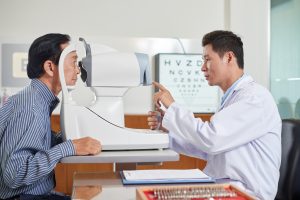
Nuclear cataract progresses slowly and can lead to greater impairment of distance vision, although close-up vision may improve. In its early stages, nuclear cataracts can result in hardening of the lens. As it progresses further, yellowing and browning of the lens occurs, causing hue discrimination, in particular with the blue end of the visual spectrum.
Nuclear cataracts is the most common form of cataracts.
Causes of nuclear cataracts
The most common cause of a nuclear cataract is aging, which unfortunately is unavoidable. A nuclear cataract begins as the hardening and yellowing of the central zone of the lens which, over time, expands outward to the other layers of the eyes.
Signs and symptoms of nuclear cataracts
Signs and symptoms of nuclear cataracts include:
- Hardening and yellowing of the nucleus of the lens
- Less light reaching the retina
- Temporary vision improvement – known as second vision
- Impaired ability to see objects at a distance
- Difficulty driving at night
- Loss of color discrimination ability
- Double vision, mainly in one eye
- The onset of other eye problems – such as myopia – due to nuclear cataracts
The longer nuclear cataracts go untreated, the greater the risk of severity and complications. As nuclear cataracts progress, greater vision loss occurs, which can become irreversible. It’s important to undergo routine eye exams and spot symptoms early to prevent such vision loss.
Treatment options for nuclear cataracts
- Improve the lighting in your home with more lighting and brighter lamps.
- Limit your night driving.
- When you go outside in daytime, wear sunglasses or a broad-brimmed hat to reduce glare.
- Avoid sunlamps and tanning booths.
- Get your eyes checked once a year (more often, if you’ve noticed problems).
- Make sure your eyeglasses or contact lenses are the most accurate prescription.
- Use a magnifying glass to read.
- Keep diabetes under control with diet, exercise, and medication.
- Quit smoking.
As mentioned, the earlier that cataracts are found, the more effective that early treatment can be to help you maintain your vision. Therefore, it’s highly important that you go for routine eye exams, especially in the old age.